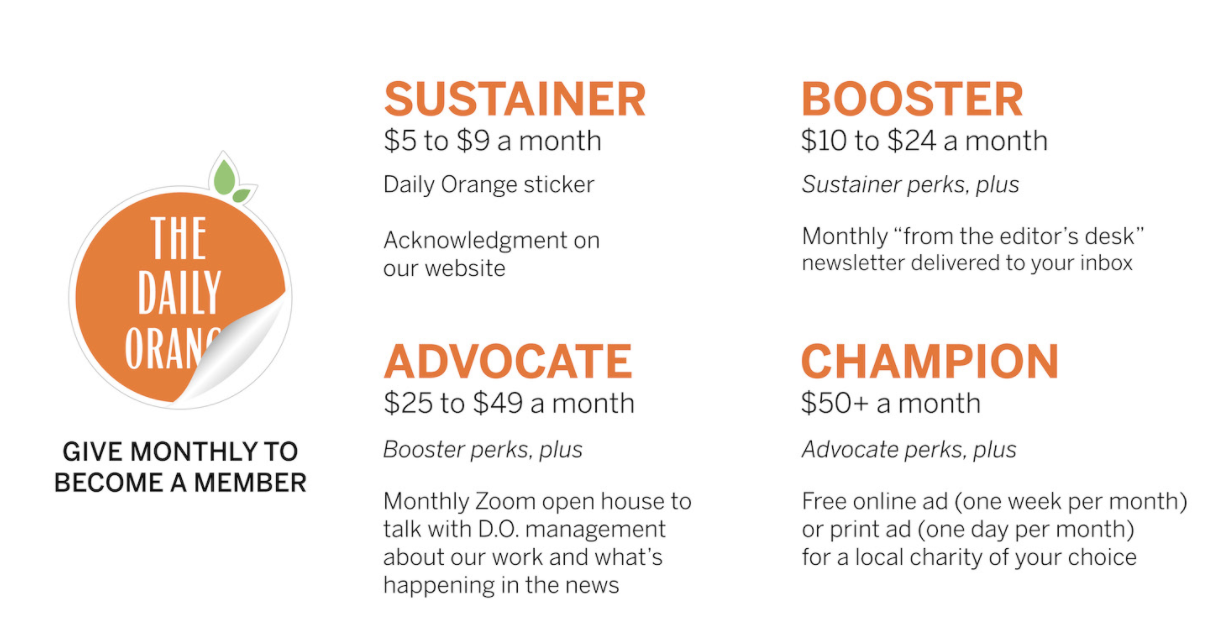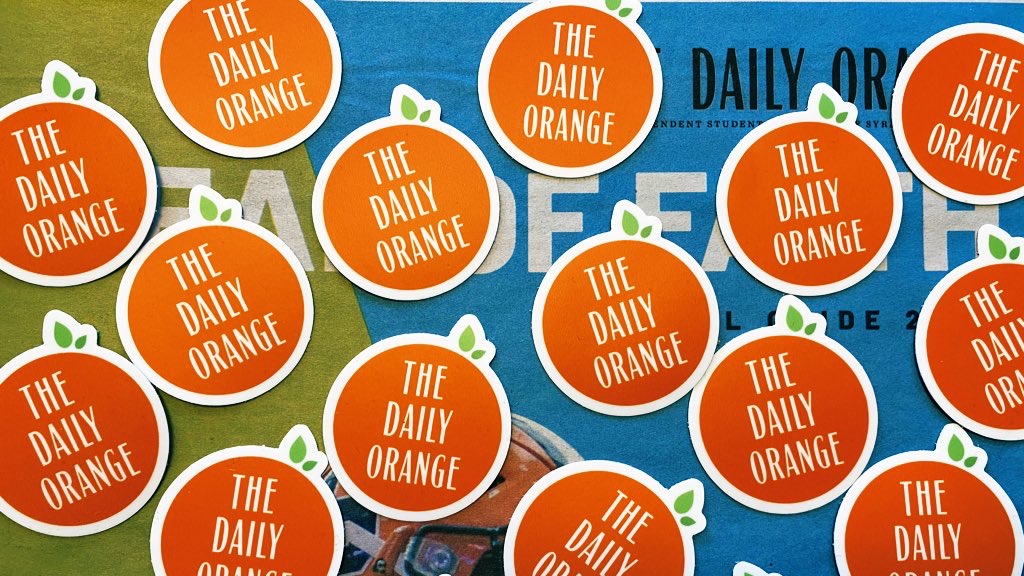The Lead is a weekly newsletter that provides resources and connections for student journalists in both college and high school. Sign up here to have it delivered to your inbox every Wednesday morning.
As coronavirus continues devastating student publications’ budgets, The Daily Orange at Syracuse University is taking a new approach: a membership program. The DO launched the program last week, hoping to connect more deeply with its community and create a sustainable revenue model for the future.
Haley Robertson, a Syracuse senior, is the DO’s first fundraising coordinator after serving as the publication’s editor-in-chief last year. She discussed the membership program’s goals and how it came about. This interview has been edited for length and clarity.
How did your background at The Daily Orange lead to this role?
As editor-in-chief last year, I focused on editorial content but also the business side: Working with the general manager and board of directors to make sure The Daily Orange would last beyond my tenure. That experience made me appreciate the business side of journalism a lot more.
I loved working on fundraising last year, connecting with supporters and bolstering the DO’s identity as a nonprofit. We’re on this campus with lots of journalism students, but we don’t get any money from the school. We’re not going to turn around and ask the school for money, because it’s really important to us that we’re independent. How can we explain that to people and explain our mission?
What does the fundraising coordinator role entail?
In this new role, I’ve had time to explore the development aspects of being a nonprofit newsroom. I work really closely with current editor-in-chief Casey Darnell to make sure we’re communicating the editorial staff’s financial needs clearly with people.
I’m seeking out grants; we had our first successful grant application this spring, with Google’s Journalism Emergency Relief Fund during the pandemic. We just haven’t been structured to be able to take the time for grants and things like that.
How have The Daily Orange’s finances been affected by the pandemic?
Advertising has been tougher when businesses were closed. Local businesses are reopening but some are at limited capacity and some don’t have it in the budget to advertise with us. We’re trying to think a little more creatively about how we partner with businesses and approach advertising. We’re shifting more advertising to online and seeing if our advertisers want to do online packages.
People aren’t out and about going to class every day, so they may not walk by one of our stands as often. We had to cut one more day of print this semester, from three days per week to two days. Right now that’s temporary and our board of directors is hoping to bring that third paper back in the spring.
Tell me about the membership program and how the idea came about.
I worked closely this summer with our fundraising committee and we were talking about how we could improve our donation platform. Our donation site had been focused on our building move last fall, and there wasn’t an option to give monthly. The messaging was outdated; a lot has happened to the DO and the world.
We started researching nonprofit news outlets who do this really well, particularly The 19th*, The Texas Tribune and ProPublica. We couldn’t really model anything off a subscription-based site, because we want our content to always be free to all of our readers. We needed to frame this in a way that people know being a member means supporting the DO, but non-members can still read our content. It’s not a paywall.
One of our alumni on the fundraising committee was the one who first pitched a membership program. We dove into how we wanted to structure it and what the tiers would be. We want this program to be something that not only DO alumni but also students, parents, families, readers, would want to be a part of.
We also talked with our managing editor and editor-in-chief about how they want to better engage with the community. How can we create this sustained two-way relationship where they feel invested in our coverage and our work?

Members will receive perks based on the amount of their recurring donation. (Screenshot via The Daily Orange)
How did you decide on the perks?
Getting an email thank you is great, but we wanted to go beyond that. We started with what tangible goodie we could commit to giving everyone, and we decided on stickers. Everyone will get a sticker with their thank you note, and maybe we could offer different things in the future.
I worked closely with our managing editor and editor-in-chief to discuss how we can better connect with our audience. The “From the Editor’s Desk” newsletter is a supplement to our regular newsletters and an opportunity for our EIC to connect with our audience on a personal level.
Memberships start at $5 per month and go up to $50+ per month. Is there a specific monthly goal?
Since this is the first time we’re doing it, we’re not sure what a feasible ballpark is. This week our goal is to kick off with 50 members. We have an alum who has committed to giving $1,000 if we reach that goal, so that’s our challenge for everyone.
(Editor’s note: The Daily Orange had 50 members within the first 12 hours of launching and now has 70, Robertson said Sept. 21.)
What have you learned so far that you want to share with other student newsrooms?
I’d suggest other newsrooms rely on people beyond their staffs who also care about their product, like alumni and readers. We sent this page to probably 25 people asking for feedback. Luckily, the DO has a really enthusiastic team between our student staff and alumni who want to make this happen.
One tool we love
The ongoing pandemic has thrown student newsrooms’ budgets into turmoil as printing schedules change and not all students are on campus. The Student Press Law Center created a College Media Survival Guide with fundraising strategies, revenue ideas and an internal assessment for your publication. (High school journalists and advisers, there’s a toolkit for you, too.) Creating a plan will help you deal with future disruptions and ensure your publication is sustainable for years to come.
What’s your favorite tool that other student journalists should know about? Email me and I might feature it in a future issue.
One story worth reading
Student newsrooms are challenging traditional norms of objectivity in their coverage of racial justice movements, Serena Cho reports for the Columbia Journalism Review. Publications have changed their policies on participating in protests and urged readers to protest and sign petitions. “There is no precedent set by legacy papers on how to do this stuff, so we have to come up with innovative ways to make journalism more diverse and inclusive,” said Marissa Martinez, editor-in-chief of the Daily Northwestern.
Opportunities and trainings
- Applications are already open for some news organizations’ summer 2021 internships. The Lead will have a full database available soon, but to get you started, a few with earlier deadlines:
- Attend a free Poynter online training Sept. 23 on helpful tools for election night reporting.
- Interested in working with local newsrooms on their election coverage? Apply for Hearken’s paid Election SOS fellowship by Sept. 29.
- The Nation is hosting a free virtual student journalism conference Oct. 9. Register here by Oct. 2.
- Apply for WBUR public radio’s yearlong newsroom fellowship by Oct. 9.
- Register for the Adobe MAX conference, a free virtual event from Oct. 20-22 featuring speakers on design, illustration, video and more.
- Registration is now open for this year’s virtual ACP/CMA conference, Oct. 22-24.









